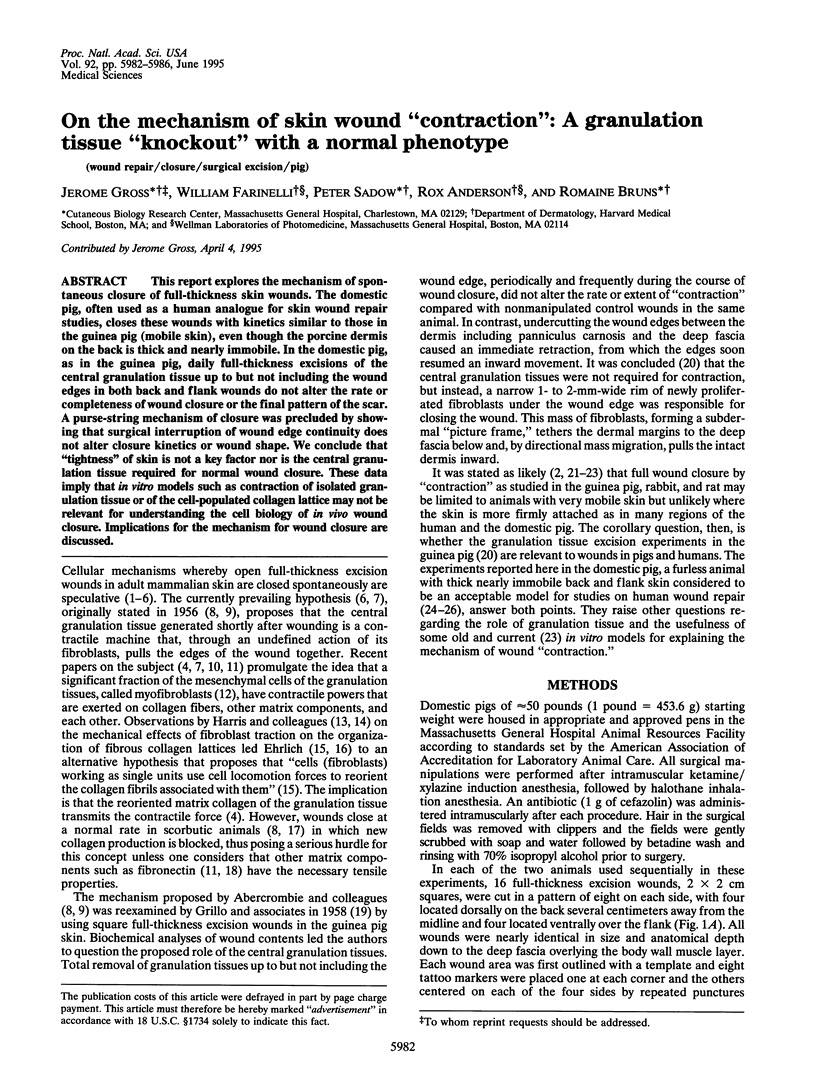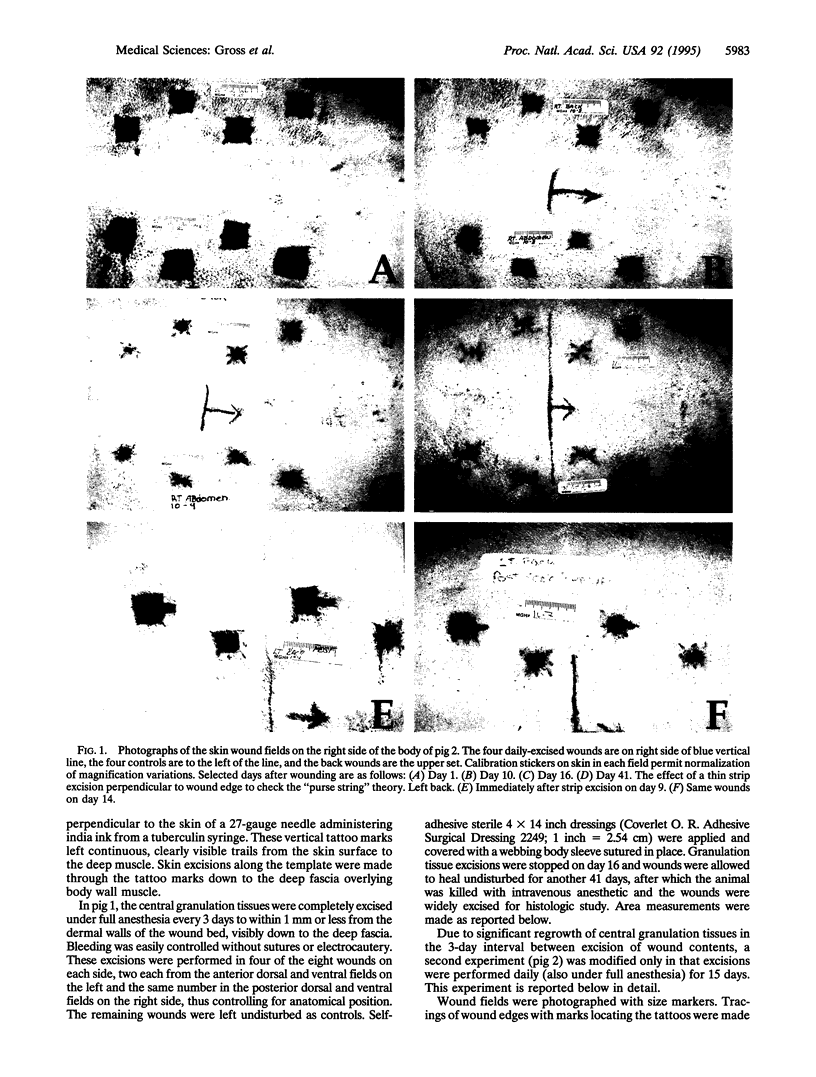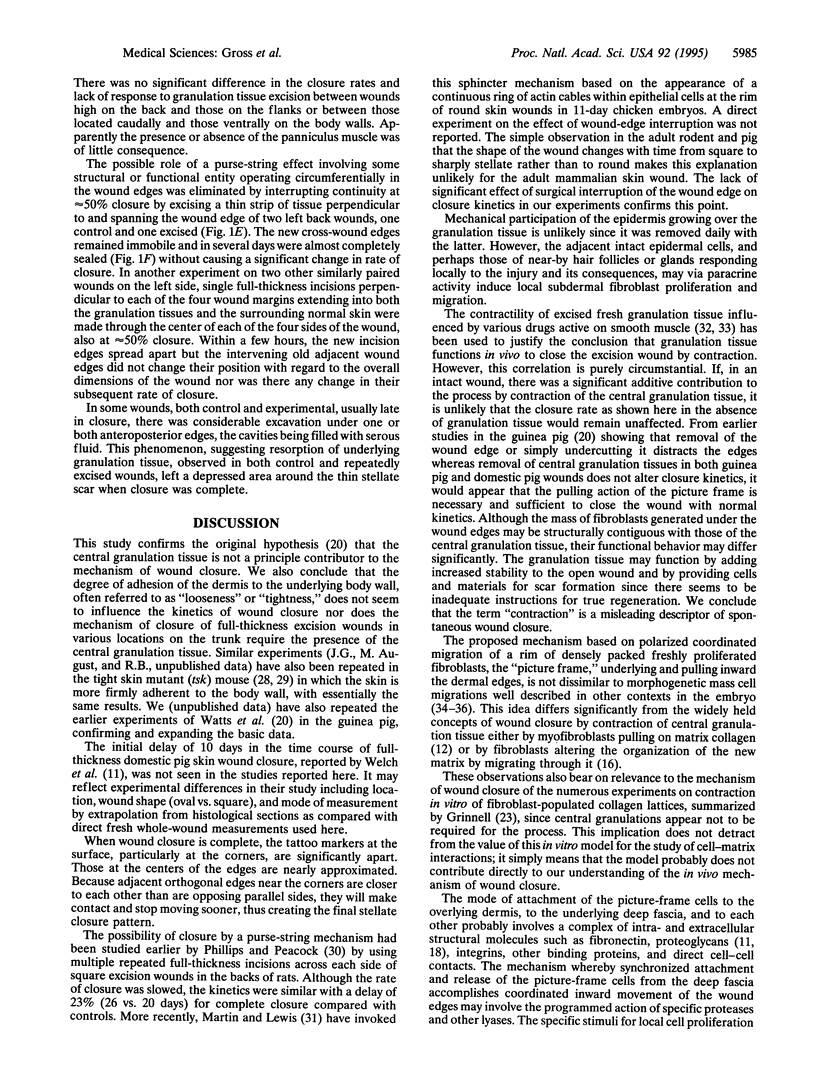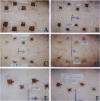Abstract
This report explores the mechanism of spontaneous closure of full-thickness skin wounds. The domestic pig, often used as a human analogue for skin wound repair studies, closes these wounds with kinetics similar to those in the guinea pig (mobile skin), even though the porcine dermis on the back is thick and nearly immobile. In the domestic pig, as in the guinea pig, daily full-thickness excisions of the central granulation tissue up to but not including the wound edges in both back and flank wounds do not alter the rate or completeness of wound closure or the final pattern of the scar. A purse-string mechanism of closure was precluded by showing that surgical interruption of wound edge continuity does not alter closure kinetics or wound shape. We conclude that "tightness" of skin is not a key factor nor is the central granulation tissue required for normal wound closure. These data imply that in vitro models such as contraction of isolated granulation tissue or of the cell-populated collagen lattice may not be relevant for understanding the cell biology of in vivo wound closure. Implications for the mechanism for wound closure are discussed.
Full text
PDF




Images in this article
Selected References
These references are in PubMed. This may not be the complete list of references from this article.
- ABERCROMBIE M., JAMES D. W., NEWCOMBE J. F. Wound contraction in rabbit skin, studied by splinting the wound margins. J Anat. 1960 Apr;94:170–182. [PMC free article] [PubMed] [Google Scholar]
- BILLINGHAM R. E., MEDAWAR P. B. Contracture and intussusceptive growth in the healing of extensive wounds in mammalian skin. J Anat. 1955 Jan;89(1):114–123. [PMC free article] [PubMed] [Google Scholar]
- BILLINGHAM R. E., RUSSELL P. S. Studies on wound healing, with special reference to the phenomenon of contracture in experimental wounds in rabbits' skin. Ann Surg. 1956 Dec;144(6):961–981. doi: 10.1097/00000658-195612000-00005. [DOI] [PMC free article] [PubMed] [Google Scholar]
- CATTY R. H. HEALING AND CONTRACTION OF EXPERIMENTAL FULL-THICKNESS WOUNDS IN THE HUMAN. Br J Surg. 1965 Jul;52:542–548. doi: 10.1002/bjs.1800520715. [DOI] [PubMed] [Google Scholar]
- Clark R. A. Regulation of fibroplasia in cutaneous wound repair. Am J Med Sci. 1993 Jul;306(1):42–48. doi: 10.1097/00000441-199307000-00011. [DOI] [PubMed] [Google Scholar]
- Darby I., Skalli O., Gabbiani G. Alpha-smooth muscle actin is transiently expressed by myofibroblasts during experimental wound healing. Lab Invest. 1990 Jul;63(1):21–29. [PubMed] [Google Scholar]
- Ehrlich H. P., Needle A. L. Wound healing in tight-skin mice: delayed closure of excised wounds. Plast Reconstr Surg. 1983 Aug;72(2):190–198. doi: 10.1097/00006534-198308000-00012. [DOI] [PubMed] [Google Scholar]
- Ehrlich H. P., Rajaratnam J. B. Cell locomotion forces versus cell contraction forces for collagen lattice contraction: an in vitro model of wound contraction. Tissue Cell. 1990;22(4):407–417. doi: 10.1016/0040-8166(90)90070-p. [DOI] [PubMed] [Google Scholar]
- Ehrlich H. P. Wound closure: evidence of cooperation between fibroblasts and collagen matrix. Eye (Lond) 1988;2(Pt 2):149–157. doi: 10.1038/eye.1988.28. [DOI] [PubMed] [Google Scholar]
- GRILLO H. C., GROSS J. Studies in wound healing. III. Contraction in vit. C. deficiency. Proc Soc Exp Biol Med. 1959 Jun;101(2):268–270. doi: 10.3181/00379727-101-24907. [DOI] [PubMed] [Google Scholar]
- GRILLO H. C. Origin of fibroblasts in wound healing. An autoradiographic study of inhibition of cellular proliferation by local x-irradiation. Ann Surg. 1963 Mar;157:453–467. doi: 10.1097/00000658-196303000-00018. [DOI] [PMC free article] [PubMed] [Google Scholar]
- GRILLO H. C., POTSAID M. S. Studies in wound healing. IV. Retardation of contraction by localx-irradiation, and observations relating to the origin of fibroblasts in repair. Ann Surg. 1961 Nov;154:741–750. [PMC free article] [PubMed] [Google Scholar]
- GRILLO H. C., WATTS G. T., GROSS J. Studies in wound healing: I. Contraction and the wound contents. Ann Surg. 1958 Aug;148(2):145–160. doi: 10.1097/00000658-195808000-00001. [DOI] [PMC free article] [PubMed] [Google Scholar]
- Gabbiani G., Ryan G. B., Majne G. Presence of modified fibroblasts in granulation tissue and their possible role in wound contraction. Experientia. 1971 May 15;27(5):549–550. doi: 10.1007/BF02147594. [DOI] [PubMed] [Google Scholar]
- Gailit J., Clark R. A. Wound repair in the context of extracellular matrix. Curr Opin Cell Biol. 1994 Oct;6(5):717–725. doi: 10.1016/0955-0674(94)90099-x. [DOI] [PubMed] [Google Scholar]
- Green M. C., Sweet H. O., Bunker L. E. Tight-skin, a new mutation of the mouse causing excessive growth of connective tissue and skeleton. Am J Pathol. 1976 Mar;82(3):493–512. [PMC free article] [PubMed] [Google Scholar]
- Grinnell F. Fibroblasts, myofibroblasts, and wound contraction. J Cell Biol. 1994 Feb;124(4):401–404. doi: 10.1083/jcb.124.4.401. [DOI] [PMC free article] [PubMed] [Google Scholar]
- Harris A. K., Stopak D., Wild P. Fibroblast traction as a mechanism for collagen morphogenesis. Nature. 1981 Mar 19;290(5803):249–251. doi: 10.1038/290249a0. [DOI] [PubMed] [Google Scholar]
- Krummel T. M., Ehrlich H. P., Nelson J. M., Michna B. A., Thomas B. L., Haynes J. H., Cohen I. K., Diegelmann R. F. In vitro and in vivo analysis of the inability of fetal rabbit wounds to contract. Wound Repair Regen. 1993 Jan;1(1):15–21. doi: 10.1046/j.1524-475X.1993.10106.x. [DOI] [PubMed] [Google Scholar]
- Le Douarin N. M. Cell migrations in embryos. Cell. 1984 Sep;38(2):353–360. doi: 10.1016/0092-8674(84)90490-2. [DOI] [PubMed] [Google Scholar]
- MONTAGNA W., YUN J. S. THE SKIN OF THE DOMESTIC PIG. J Invest Dermatol. 1964 Jul;42:11–21. [PubMed] [Google Scholar]
- Madden J. W., Morton D., Jr, Peacock E. E., Jr Contraction of experimental wounds. I. Inhibiting wound contraction by using a topical smooth muscle antagonist. Surgery. 1974 Jul;76(1):8–15. [PubMed] [Google Scholar]
- Marcarian H. Q., Calhoun M. L. Microscopic anatomy of the integument of adult swine. Am J Vet Res. 1966 May;27(118):765–772. [PubMed] [Google Scholar]
- Martin P., Lewis J. Actin cables and epidermal movement in embryonic wound healing. Nature. 1992 Nov 12;360(6400):179–183. doi: 10.1038/360179a0. [DOI] [PubMed] [Google Scholar]
- Quaglino D., Jr, Nanney L. B., Ditesheim J. A., Davidson J. M. Transforming growth factor-beta stimulates wound healing and modulates extracellular matrix gene expression in pig skin: incisional wound model. J Invest Dermatol. 1991 Jul;97(1):34–42. [PubMed] [Google Scholar]
- Repesh L. A., Fitzgerald T. J., Furcht L. T. Fibronectin involvement in granulation tissue and wound healing in rabbits. J Histochem Cytochem. 1982 Apr;30(4):351–358. doi: 10.1177/30.4.6174568. [DOI] [PubMed] [Google Scholar]
- Rovasio R. A., Delouvee A., Yamada K. M., Timpl R., Thiery J. P. Neural crest cell migration: requirements for exogenous fibronectin and high cell density. J Cell Biol. 1983 Feb;96(2):462–473. doi: 10.1083/jcb.96.2.462. [DOI] [PMC free article] [PubMed] [Google Scholar]
- SASAKI T., CARLSON L. D. EFFECT OF A STEP CHANGE IN TEMPERATURE ON SKIN TEMPERATURE AND BLOOD FLOW. Proc Soc Exp Biol Med. 1964 Nov;117:334–338. doi: 10.3181/00379727-117-29574. [DOI] [PubMed] [Google Scholar]
- Stopak D., Harris A. K. Connective tissue morphogenesis by fibroblast traction. I. Tissue culture observations. Dev Biol. 1982 Apr;90(2):383–398. doi: 10.1016/0012-1606(82)90388-8. [DOI] [PubMed] [Google Scholar]
- Tranquillo R. T., Murray J. D. Mechanistic model of wound contraction. J Surg Res. 1993 Aug;55(2):233–247. doi: 10.1006/jsre.1993.1135. [DOI] [PubMed] [Google Scholar]
- Van Winkle W., Jr Wound contraction. Surg Gynecol Obstet. 1967 Jul;125(1):131–142. [PubMed] [Google Scholar]
- Watts G. T., Grillo H. C., Gross J. Studies in Wound Healing: II. The Role of Granulation Tissue in Contraction. Ann Surg. 1958 Aug;148(2):153–160. doi: 10.1097/00000658-195808000-00002. [DOI] [PMC free article] [PubMed] [Google Scholar]
- Welch M. P., Odland G. F., Clark R. A. Temporal relationships of F-actin bundle formation, collagen and fibronectin matrix assembly, and fibronectin receptor expression to wound contraction. J Cell Biol. 1990 Jan;110(1):133–145. doi: 10.1083/jcb.110.1.133. [DOI] [PMC free article] [PubMed] [Google Scholar]



